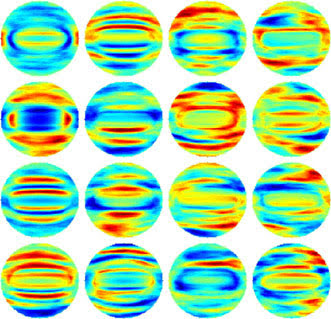Pairing holographic microscopy with machine learning software could help hospitals and the food industry screen for bacterial infection in real time.
A quantitative phase imaging unit (QPIU) developed at the Korea Advanced Institute of Science and Technology (KAIST) converts standard optical microscopes into holographic microscopes capable of performing the analysis. The researchers plan to test the system next month in Tanzania.
In a lab trial, the system distinguished between four types of bacteria with greater than 94 percent accuracy, the researchers said.

Representative major light scattering patterns of a single bacterium, form which its species, L. casei, was identified from a machine learning algorithm. Courtesy of YoungJu Jo and YongKeun Park/Korea Advanced Institute of Science and Technology.
The trial used L. monocytogenes, E. coli, L. casei and B. subtilis, which are all rod-shaped and virtually impossible to distinguish by eye. The first three are all pathogens known to infect humans through the food chain or via hospital-acquired infections. The fourth is a harmless bacterium used in laboratory research because it is closely related to the deadly Bacillus anthracis, which causes anthrax.
The QPIU process relies on Fourier transform light scattering (FTLS) measurements to create 2-D angle-resolved light scattering maps of the bacteria. The maps are then fed through machine learning software, similar to that used for facial recognition, which identifies individual strains almost immediately.
This is the first time anyone has applied machine learning to FTLS data, according to KAIST professor and team leader YongKeun Park.
"Employing laser holographic techniques, we achieved rapid and label-free identification of bacterial species at the single-bacterium level with a single-shot measurement," Park said. "This means the present method can be utilized as a prescreening test for point-of-care bacterial diagnosis for various applications including medicine and food hygiene."
If the approach proves to be effective in controlled clinical trials, it could lead to a powerful new way of routinely identifying dangerous bacteria at the point of care, in food processing facilities or in homeland security applications, the researchers said.
Today it normally takes days to culture microbes from a patient's blood in the laboratory, which is still the gold standard in the health care industry for making a definitive diagnosis. Also routinely used today is a newer method based on DNA analysis called quantitative polymerase chain reaction (qPCR), but it still may take hours to return a result, and it requires sample preparation that is often cost-prohibitive for routine use in rural or resource-poor settings.
The challenge of meeting clinical needs in the developing world was one of the motivations behind the work, according to the KAIST team. They wanted to find an inexpensive method that could surpass the speed of qPCR.
The research was published in Optics Express (doi: 10.1364/OE.23.015792).
For more information, visit www.kaist.edu.